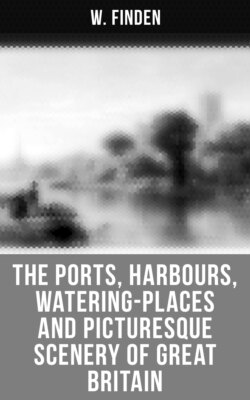Читать книгу The Ports, Harbours, Watering-places and Picturesque Scenery of Great Britain - W. Finden - Страница 21
На сайте Литреса книга снята с продажи.
SUNDERLAND.
THE BRIDGE FROM THE WESTWARD.
ОглавлениеTable of Contents
Under the general name of Sunderland, the three townships of Monk-Wearmouth, Bishop-Wearmouth, and Sunderland are usually comprised. Monk-Wearmouth is situated on the north side of the river Wear, at a short distance from its mouth. Sunderland and Bishop-Wearmouth, which form one continuous town, lie on the south side of the river; Sunderland, properly so called, extending from the line of junction of the two parishes, eastward to the sea; and Bishop-Wearmouth extending towards the west. Sunderland—which has given its name to the port and to the borough—is 269 miles distant from London; fourteen from Durham; and thirteen from Newcastle-on-Tyne.
The great boast of Sunderland is the beautiful iron bridge, of a single arch, which connects it with Monk-Wearmouth. This noble structure, which is at once highly ornamental and useful, was projected by Rowland Burdon, Esq., of Castle Eden, who in 1792, he being then M.P. for the county of Durham, obtained an act of parliament empowering him to raise money for its erection; the sums advanced to be secured on the tolls, with five per cent. interest, and all further accumulation to go in discharge of the capital. The abutments, from which the arch springs, are nearly solid masses of masonry, twenty-four feet thick, forty-two feet broad at bottom, and thirty-seven feet broad at top. That on the south side is founded on a solid rock, which rises above the level of the Wear; the foundation of that on the north side, owing to the unfavourable nature of the ground, was obliged to be laid ten feet below the level of the river. The arch, which is a segment of a large circle, is of 236 feet span, and its centre is ninety-four feet above the level of the river at low water. From the height of the arch and its comparative flatness—its versed sine, or perpendicular height from its centre to a line joining its extremities, being only thirty-four feet—ships of 300 tons burden can pass underneath not only directly below the centre, but also to the extent of fifty feet on each side. The navigation of the river thus remains unobstructed—for many vessels proceed to the staiths above the bridge for the purpose of taking in their coals—while the inhabitants on each side enjoy all the advantages of facilitated intercourse. The breadth of the bridge at the top is thirty-two feet including the footpaths on each side; and the carriage-way is formed of lime, marl, and gravel, above a flooring of timber, which is laid across the iron ribs of the arch. The iron ribs and blocks were cast and prepared at the foundry of Messrs. Walker, at Rotherham, near Sheffield. The whole weight of the iron is 260 tons; of which 46 tons are malleable, and 214 cast. The foundation-stone[4] was laid on the 24th September, 1793, and the bridge opened to the public on the 9th August, 1796, having been completed under the superintendence of Mr. Thomas Wilson, of Bishop-Wearmouth, in less than three years. The total expense was £26,000, of which sum £22,000 was subscribed by Mr. Burdon.[5]
Although many ships are loaded direct from such staiths as are at a short distance above the bridge, yet the greater part of the coals are brought down in keels from staiths situated higher up the river. The keels of the Wear, though of the same tonnage as those of the Tyne, are somewhat differently built, being flatter in the bottom, and of a lighter draught of water. The Sunderland keels are managed by only one man, who usually has a boy to assist him. In the Wear the coals when in bulk are cast from the keel into the ship by men called coal-casters; while on the Tyne, where the crew of each keel consists of three men and a boy, the coals are always cast by the keelmen. Within the last few years, a considerable quantity of coals, in order to prevent the breakage occasioned by discharging them into the keels from the spout, and then casting them into the ship, have been put on board the keels in tubs, which are afterwards raised by machinery to the vessel's deck, and then discharged into the hold. These tubs are exactly like coal waggons without their wheels, and contain the same quantity—one Newcastle chalder, or fifty-three cwt.[6] Each keel carries eight of these tubs. The number of keels employed on the Wear is above 500.
ENTRANCE TO SHIELDS HARBOUR.
